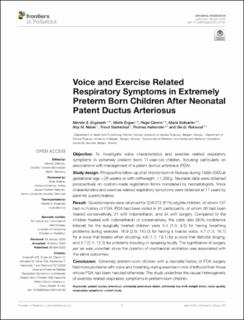Voice and Exercise Related Respiratory Symptoms in Extremely Preterm Born Children After Neonatal Patent Ductus Arteriosus
Engeseth, Merete Salveson; Engan, Mette; Clemm, Hege Synnøve Havstad; Vollsæter, Maria; Nilsen, Roy Miodini; Markestad, Trond Jacob; Halvorsen, Thomas; Røksund, Ola Drange
Peer reviewed, Journal article
Published version
Permanent lenke
https://hdl.handle.net/11250/2653985Utgivelsesdato
2020Metadata
Vis full innførselSamlinger
- Import fra CRIStin [3604]
- Institutt for helse- og omsorgsvitskap [2776]
Originalversjon
Engeseth, M. S., Engan, M., Clemm, H., Vollsæter, M., Nilsen, R. M., Markestad, T., . . . Røksund, O. D. (2020). Voice and exercise related respiratory symptoms in extremely preterm born children after neonatal patent ductus arteriosus. Frontiers in Pediatrics, 8 10.3389/fped.2020.00150Sammendrag
Objective: To investigate voice characteristics and exercise related respiratory symptoms in extremely preterm born 11-year-old children, focusing particularly on associations with management of a patent ductus arteriosus (PDA).
Study design: Prospective follow-up of all children born in Norway during 1999–2000 at gestational age <28 weeks or with birthweight <1,000 g. Neonatal data were obtained prospectively on custom-made registration forms completed by neonatologists. Voice characteristics and exercise related respiratory symptoms were obtained at 11 years by parental questionnaires.
Result: Questionnaires were returned for 228/372 (61%) eligible children, of whom 137 had no history of PDA. PDA had been noted in 91 participants, of whom 36 had been treated conservatively, 21 with indomethacin, and 34 with surgery. Compared to the children treated with indomethacin or conservatively, the odds ratio (95% confidence interval) for the surgically treated children were 3.4 (1.3; 9.2) for having breathing problems during exercise, 16.9 (2.0; 143.0) for having a hoarse voice, 4.7 (1.3; 16.7) for a voice that breaks when shouting, 4.6 (1.1; 19.1) for a voice that disturbs singing, and 3.7 (1.1; 12.3) for problems shouting or speaking loudly. The significance of surgery per se was uncertain since the duration of mechanical ventilation was associated with the same outcomes.
Conclusion: Extremely preterm born children with a neonatal history of PDA surgery had more problems with voice and breathing during exercise in mid-childhood than those whose PDA had been handled otherwise. The study underlines the causal heterogeneity of exercise related respiratory symptoms in preterm born children.

